Structural Equation Model in Landscape Performance Research: Dimensions, Methodologies, and Recommendations
Abstract
1. Introduction
1.1. Landscape Performance
1.2. Structural Equation Modeling
2. Methods
2.1. Article Selection
2.2. CiteSpace Analysis
2.3. Thematic Analysis
3. Results
3.1. Preliminary Bibliometric Analysis Visualized Using CiteSpace
3.2. Research Dimensions
3.3. Analytical Methods
3.4. Data Types
4. Discussion
4.1. Research Dimensions of SEM-Based LP Research
- (1)
- Ecological environment performance
- (2)
- Built Environment Performance
- (3)
- Cognitive Environment Performance
- (4)
- Summary
4.2. Analytical Methods for SEM-Based LP Research
- (1)
- Correlation mechanism analysis
- (2)
- Mediation effect analysis
- (3)
- Multi-group analysis
- (4)
- Multitype measurements
4.3. Data Selection for SEM-Based LP Research
4.4. Trends and Recommendations
5. Conclusions
- Integrate landscape and cognitive environment performance: conduct long-term analyses to identify construction models and evolutionary trends over the entire lifecycle.
- Establish an open-source database: share spatial information and theoretical models, integrating SEM with geographic information technologies to enhance spatial analysis precision.
- Apply research findings in design practices: validate results through case studies and continuously track the performance of real landscape renewal projects.
Supplementary Materials
Author Contributions
Funding
Data Availability Statement
Conflicts of Interest
References
- Zhang, Y.; Jin, Y.; Steemers, K.; Cao, K. 3.20—The Study of the Effects of Built Form on Pedestrian Activities: A GIS-Based Integrated Approach. In Comprehensive Geographic Information Systems; Huang, B., Ed.; Elsevier: Oxford, UK, 2018; pp. 330–344. ISBN 978-0-12-804793-4. [Google Scholar]
- Barnes, M. Landscape Performance in Practice: Insights and Recommendations. Landsc. Rev. 2024, 20, 18–26. [Google Scholar] [CrossRef]
- Yang, B.; Li, S.; Binder, C. A Research Frontier in Landscape Architecture: Landscape Performance and Assessment of Social Benefits. Landsc. Res. 2016, 41, 314–329. [Google Scholar] [CrossRef]
- Marsh, W.M. Landscape Planning: Environmental Applications; Wiley: New York, NY, USA, 2005. [Google Scholar]
- Shen, Z.; Peng, X.; Du, C.; Kim, M. Quantifying Sustainability and Landscape Performance: A Smart Devices Assisted Alternative Framework. Sustainability 2023, 15, 13239. [Google Scholar] [CrossRef]
- Lin, H.; Wang, J.-B.; Zhang, X.; Hu, F.; Liu, J.; Hong, X.-C. Historical Sensing: The Spatial Pattern of Soundscape Occurrences Recorded in Poems between the Tang and the Qing Dynasties amid Urbanization. Humanit. Soc. Sci. Commun. 2024, 11, 730. [Google Scholar] [CrossRef]
- Feng, L.; Wang, J.; Liu, B.; Hu, F.; Hong, X.; Wang, W. Does Urban Green Space Pattern Affect Green Space Noise Reduction? Forests 2024, 15, 1719. [Google Scholar] [CrossRef]
- Luo, Y.; Li, M.-H. A Study of Landscape Performance: Do Social, Economic and Environmental Benefits Always Complement Each Other? Landsc. Archit. Front. 2014, 2, 42–56. [Google Scholar]
- Ndubisi, F.; Whitlow, H.; Deutsch, B. Landscape Performance: Past, Present, and Future. Landsc. Archit. 2015, 1, 40–51. [Google Scholar] [CrossRef]
- Yang, Y.; Lin, G. The development, connotations, and interests of research on landscape performance evaluation for evidence-based design. Landsc. Archit. Front. 2020, 8, 74–83. [Google Scholar] [CrossRef]
- Chen, Z. Assessing the Impact of High-density High-heterogeneity Urban District Landscape on Psychological Health and Optimizing via Evidence-based Design. Landsc. Archit. 2018, 25, 106–111. [Google Scholar] [CrossRef]
- Wang, J.; Zhu, A.; Wang, M. Correlating Physical Forms of Riparian Zones in Urban Parks with Effective Eco-services Provision of Water Self-purification: A Case Study of Shanghai Mengqing Park. Landsc. Archit. 2016, 8, 118–127. [Google Scholar] [CrossRef]
- Spearman, C. The Proof and Measurement of Association between Two Things. Am. J. Psychol. 1904, 15, 72–101. [Google Scholar] [CrossRef]
- Wright, S. The Method of Path Coefficients. Ann. Math. Stat. 1934, 5, 161–215. [Google Scholar] [CrossRef]
- Mueller, R.O. Basic Principles of Structural Equation Modeling; Springer Texts in Statistics; Springer: New York, NY, USA, 1996; ISBN 978-1-4612-8455-0. [Google Scholar]
- Hershberger, S.L. The Growth of Structural Equation Modeling: 1994–2001. Struct. Equ. Model. 2003, 10, 35–46. [Google Scholar] [CrossRef]
- Peng, J.; Yan, S.; Strijker, D.; Wu, Q.; Chen, W.; Ma, Z. The Influence of Place Identity on Perceptions of Landscape Change: Exploring Evidence from Rural Land Consolidation Projects in Eastern China. Land Use Policy 2020, 99, 104891. [Google Scholar] [CrossRef]
- Sharafatmandrad, M.; Khosravi Mashizi, A. Visual Value of Rangeland Landscapes: A Study Based on Structural Equation Modeling. Ecol. Eng. 2020, 146, 105742. [Google Scholar] [CrossRef]
- Spasojevic, M.J.; Grace, J.B.; Harrison, S.; Damschen, E.I. Functional Diversity Supports the Physiological Tolerance Hypothesis for Plant Species Richness along Climatic Gradients. J. Ecol. 2014, 102, 447–455. [Google Scholar] [CrossRef]
- Grace, J.B.; Anderson, T.M.; Seabloom, E.W.; Borer, E.T.; Adler, P.B.; Harpole, W.S.; Hautier, Y.; Hillebrand, H.; Lind, E.M.; Pärtel, M.; et al. Integrative Modelling Reveals Mechanisms Linking Productivity and Plant Species Richness. Nature 2016, 529, 390–393. [Google Scholar] [CrossRef]
- Iacobucci, D.; Saldanha, N.; Deng, X. A Meditation on Mediation: Evidence That Structural Equations Models Perform Better Than Regressions. J. Consum. Psychol. 2007, 17, 139–153. [Google Scholar] [CrossRef]
- Zhao, X.; Lynch, J.G., Jr.; Chen, Q. Reconsidering Baron and Kenny: Myths and Truths about Mediation Analysis. J. Consum. Res. 2010, 37, 197–206. [Google Scholar] [CrossRef]
- Moher, D.; Liberati, A.; Tetzlaff, J.; Altman, D.G.; The PRISMA Group. Preferred Reporting Items for Systematic Reviews and Meta-Analyses: The PRISMA Statement. PLoS Med. 2009, 6, e1000097. [Google Scholar] [CrossRef]
- Tranfield, D.; Denyer, D.; Smart, P. Towards a Methodology for Developing Evidence-Informed Management Knowledge by Means of Systematic Review. Br. J. Manag. 2003, 14, 207–222. [Google Scholar] [CrossRef]
- Chen, C. CiteSpace II: Detecting and Visualizing Emerging Trends and Transient Patterns in Scientific Literature. J. Am. Soc. Inf. Sci. Technol. 2006, 57, 359–377. [Google Scholar] [CrossRef]
- Waltman, L.; van Eck, N.J.; Noyons, E.C.M. A Unified Approach to Mapping and Clustering of Bibliometric Networks. J. Informetr. 2010, 4, 629–635. [Google Scholar] [CrossRef]
- Origin. 2025. Available online: https://www.originlab.com/getstarted (accessed on 25 February 2025).
- Van Acker, V.; Witlox, F. Commuting Trips within Tours: How Is Commuting Related to Land Use? Transportation 2011, 38, 465–486. [Google Scholar] [CrossRef]
- Zhou, Y.; Yang, L.; Yu, J.; Guo, S. Do Seasons Matter? Exploring the Dynamic Link between Blue-Green Space and Mental Restoration. Urban For. Urban Green. 2022, 73, 127612. [Google Scholar] [CrossRef]
- Eisenhauer, N.; Bowker, M.A.; Grace, J.B.; Powell, J.R. From Patterns to Causal Understanding: Structural Equation Modeling (SEM) in Soil Ecology. Pedobiologia 2015, 58, 65–72. [Google Scholar] [CrossRef]
- Grace, J.B. Structural Equation Modeling and Natural Systems; Cambridge University Press: Cambridge, UK, 2006; ISBN 978-0-521-54653-9. [Google Scholar]
- Zhu, Y.; Liu, C.; Peng, C.; Zhou, X.; Xie, B.; Li, T.; Li, P.; Zou, Z.; Tang, J.; Liu, Z. Applications of Structural Equation Modeling in Plant Functional Trait Research. Environ. Rev. 2024, 32, 525–538. [Google Scholar] [CrossRef]
- Yin, Z.; Zhang, Y.; Zhang, R.; Chen, G.; Cong, Y.; Ma, K. Structure of an Urban Green Space Indirectly Affects the Distribution of Airborne Particulate Matter: A Study Based on Structural Equation Modelling. Urban For. Urban Green. 2022, 72, 127581. [Google Scholar] [CrossRef]
- Chen, X.; Pei, T.; Zhou, Z.; Teng, M.; He, L.; Luo, M.; Liu, X. Efficiency Differences of Roadside Greenbelts with Three Configurations in Removing Coarse Particles (PM10): A Street Scale Investigation in Wuhan, China. Urban For. Urban Green. 2015, 14, 354–360. [Google Scholar] [CrossRef]
- Cervero, R.; Kockelman, K. Travel Demand and the 3Ds: Density, Diversity, and Design. Transp. Res. Part Transp. Environ. 1997, 2, 199–219. [Google Scholar] [CrossRef]
- Gehl, J. Cities for People; Island Press: Washington, DC, USA, 2013; ISBN 978-1-59726-984-1. [Google Scholar]
- Nicolas, C.; Kim, J.; Chi, S. Quantifying the Dynamic Effects of Smart City Development Enablers Using Structural Equation Modeling. Sustain. Cities Soc. 2020, 53, 101916. [Google Scholar] [CrossRef]
- Kline, R.B. Principles and Practice of Structural Equation Modeling, 4th ed; Guilford Press: New York, NY, USA, 2016; ISBN 978-1-4625-2334-4. [Google Scholar]
- Li, Z.; Han, X.; Lin, X.; Lu, X. Quantitative Analysis of Landscape Efficacy Based on Structural Equation Modelling: Empirical Evidence from New Chinese Style Commercial Streets. Alex. Eng. J. 2021, 60, 261–271. [Google Scholar] [CrossRef]
- Bechtel, R.B.; Marans, R.W.; Michelson, W. Methods in Environmental and Behavioral Research; Van Nostrand Reinhold Co.: New York, NY, USA, 1987; ISBN 978-0-442-21157-8. [Google Scholar]
- Moore, G.T. New Directions for Environment-Behavior Research in Architecture. Center for Architecture and Urban Planning Research, University of Wisconsin: Madison, WI, USA, 1981. [Google Scholar]
- Purcell, A.T. Landscape Perception, Preference, and Schema Discrepancy. Environ. Plan. B Plan. Des. 1987, 14, 67–92. [Google Scholar] [CrossRef]
- Hashemnezhad, H.; Heidari, A.A.; Mohammad Hoseini, P. Sense of Place” and “place Attachment. Int. J. Archit. Urban Dev. 2013, 3, 5–12. [Google Scholar]
- Fiske, S.T.; Cuddy, A.J.C.; Glick, P. Universal Dimensions of Social Cognition: Warmth and Competence. Trends Cogn. Sci. 2007, 11, 77–83. [Google Scholar] [CrossRef]
- Kaplan, S. The Restorative Benefits of Nature: Toward an Integrative Framework. J. Environ. Psychol. 1995, 15, 169–182. [Google Scholar] [CrossRef]
- Ajzen, I. From Intentions to Actions: A Theory of Planned Behavior. In Action Control: From Cognition to Behavior; Kuhl, J., Beckmann, J., Eds.; Springer: Berlin/Heidelberg, Germany, 1985; pp. 11–39. ISBN 978-3-642-69746-3. [Google Scholar]
- Li, W.; Feng, T.; Timmermans, H.J.P.; Li, Z.; Zhang, M.; Li, B. Analysis of Citizens’ Motivation and Participation Intention in Urban Planning. Cities 2020, 106, 102921. [Google Scholar] [CrossRef]
- Shahangian, S.A.; Rajabi, M.; Zobeidi, T.; Tabesh, M.; Yazdanpanah, M.; Hajibabaei, M.; Ghazizadeh, M.J.; Sitzenfrei, R. Perceptions of How Occupants Adopt Water Conservation Behaviors under Psychosocial Processes: A Complementary Dual-Stage SEM-ANN Perspective. Sustain. Cities Soc. 2024, 106, 105354. [Google Scholar] [CrossRef]
- Guo, X.; Liu, J.; Albert, C.; Hong, X.-C. Audio-Visual Interaction and Visitor Characteristics Affect Perceived Soundscape Restorativeness: Case Study in Five Parks in China. Urban For. Urban Green. 2022, 77, 127738. [Google Scholar] [CrossRef]
- van Wee, B.; De Vos, J.; Maat, K. Impacts of the Built Environment and Travel Behaviour on Attitudes: Theories Underpinning the Reverse Causality Hypothesis. J. Transp. Geogr. 2019, 80, 102540. [Google Scholar] [CrossRef]
- Hui, H.; Liu, B.; Sun, Y.; Zhang, S. Influential Factors and Mechanism of Sense of Place in Historic Districts. In Proceedings of the Proceedings of 5th International Conference on Civil Engineering and Architecture, Hanoi, Vietnam, 16–18 December 2022; Kang, T., Ed.; Springer Nature: Singapore, 2024; pp. 935–945. [Google Scholar]
- Mullenbach, L.E.; Larson, L.R.; Floyd, M.F.; Marquet, O.; Huang, J.-H.; Alberico, C.; Scott Ogletree, S.; Aaron Hipp, J. Cultivating Social Capital in Diverse, Low-Income Neighborhoods: The Value of Parks for Parents with Young Children. Landsc. Urban Plan. 2022, 219, 104313. [Google Scholar] [CrossRef]
- Peng, J.; Qi, J.; Cui, C.; Yan, J.; Dai, Q.; Yang, H. Research on the Impact of the Built Environment on the Characteristics of Metropolis Rail Transit School Commuting—Take Wuhan as an Example. Int. J. Environ. Res. Public. Health 2021, 18, 9885. [Google Scholar] [CrossRef]
- Chang, P.-J.; Tsou, C.-W.; Li, Y.-S. Urban-Greenway Factors’ Influence on Older Adults’ Psychological Well-Being: A Case Study of Taichung, Taiwan. Urban For. Urban Green. 2020, 49, 126606. [Google Scholar] [CrossRef]
- Huang, Y.; Aguilar, F.; Yang, J.; Qin, Y.; Wen, Y. Predicting Citizens’ Participatory Behavior in Urban Green Space Governance: Application of the Extended Theory of Planned Behavior. Urban For. Urban Green. 2021, 61, 127110. [Google Scholar] [CrossRef]
- Xue, F.; Yao, E.; Jin, F. Exploring Residential Relocation Behavior for Families with Workers and Students: A Study from Beijing, China. J. Transp. Geogr. 2020, 89, 102893. [Google Scholar] [CrossRef]
- Crawford, D.W.; Jackson, E.L.; Godbey, G. A Hierarchical Model of Leisure Constraints. Leis. Sci. 1991, 13, 309–320. [Google Scholar] [CrossRef]
- Li, Z.; Lin, X.; Han, X.; Lu, X.; Zhao, H. Landscape Efficiency Assessment of Urban Subway Station Entrance Based on Structural Equation Model: Case Study of Main Urban Area of Nanjing. Buildings 2022, 12, 294. [Google Scholar] [CrossRef]
- Ul Islam, J.; Rahman, Z. The Impact of Online Brand Community Characteristics on Customer Engagement: An Application of Stimulus-Organism-Response Paradigm. Telemat. Inform. 2017, 34, 96–109. [Google Scholar] [CrossRef]
- Koohsari, M.J.; Badland, H.; Sugiyama, T.; Mavoa, S.; Christian, H.; Giles-Corti, B. Mismatch between Perceived and Objectively Measured Land Use Mix and Street Connectivity: Associations with Neighborhood Walking. J. Urban Health 2015, 92, 242–252. [Google Scholar] [CrossRef]
- Ma, L.; Dill, J.; Mohr, C. The Objective versus the Perceived Environment: What Matters for Bicycling? Transportation 2014, 41, 1135–1152. [Google Scholar] [CrossRef]
- Kaplan, D. Structural Equation Modeling: Foundations and Extensions, 2nd ed.; SAGE Publications, Inc.: Thousand Oaks, CA, USA, 2009; ISBN 978-1-4522-2657-6. [Google Scholar]
- Li, W.; Liu, Y. Predicting the Impact of Integrated Audio-Visual Environments on Perceived Restorative Benefits across Different Park Types: A Field Study Based on Seven Parks in Hangzhou, China. Urban For. Urban Green. 2024, 101, 128517. [Google Scholar] [CrossRef]
- Li, Z. Returning to land: A case study of landscape architecture based on site type. Landsc. Archit. 2015, 4, 117–118. [Google Scholar]
- Davies, F.; Goode, M.; Mazanec, J.; Moutinho, L. LISREL and Neural Network Modelling: Two Comparison Studies. J. Retail. Consum. Serv. 1999, 6, 249–262. [Google Scholar] [CrossRef]
- Zhou, Y.; Zhang, L.; Chiaradia, A.J.F. An Adaptation of Reference Class Forecasting for the Assessment of Large-Scale Urban Planning Vision, a SEM-ANN Approach to the Case of Hong Kong Lantau Tomorrow. Land Use Policy 2021, 109, 105701. [Google Scholar] [CrossRef]
- Jiang, X.; Ji, L.; Chen, Y.; Zhou, C.; Ge, C.; Zhang, X. How to Improve the Well-Being of Youths: An Exploratory Study of the Relationships among Coping Style, Emotion Regulation, and Subjective Well-Being Using the Random Forest Classification and Structural Equation Modeling. Front. Psychol. 2021, 12, 637712. [Google Scholar] [CrossRef]
- Hong, W.; Wang, Y. Evaluation of Highway Construction Foreman’s Competency Based on Support Vector Machine. J. Phys. Conf. Ser. 2019, 1168, 032106. [Google Scholar] [CrossRef]
- Rudincová, K.Ž.; Ženka, J.; Bosák, V.; Slach, O.; Istrate, A.; Nováček, A. Perception and Preferred Reuse of Vegetated Vacant Lots along Main Streets in a Shrinking City. Urban For. Urban Green. 2023, 85, 127956. [Google Scholar] [CrossRef]
- Hu, X.; Dong, C.; Zhang, Y. Dynamic Evolution of the Ecological Footprint of Arable Land in the Yellow and Huaihai Main Grain Producing Area Based on Structural Equation Modeling and Analysis of Driving Factors. Ecol. Inform. 2024, 82, 102720. [Google Scholar] [CrossRef]
- Martilla, J.A.; James, J.C. Importance-Performance Analysis. J. Mark. 1977, 41, 77–79. [Google Scholar] [CrossRef]
- Li, H.; Lv, L.; Zuo, J.; Bartsch, K.; Wang, L.; Xia, Q. Determinants of Public Satisfaction with an Urban Water Environment Treatment PPP Project in Xuchang, China. Sustain. Cities Soc. 2020, 60, 102244. [Google Scholar] [CrossRef]
- Cawson, J.G.; Burton, J.E.; Pickering, B.J.; Penman, T.D. Moisture Thresholds for Ignition Vary between Types of Eucalypt Forests across an Aridity Gradient. Landsc. Ecol. 2024, 39, 70. [Google Scholar] [CrossRef]
- Wu, Y.; Liu, Y.; Zeng, H. Ecosystem Service Supply–Demand Ratio Zoning and Thresholds of the Key Influencing Factors in the Pearl River Delta, China. Landsc. Ecol. 2024, 39, 162. [Google Scholar] [CrossRef]
- Li, D.; Cao, W.; Dou, Y.; Wu, S.; Liu, J.; Li, S. Non-Linear Effects of Natural and Anthropogenic Drivers on Ecosystem Services: Integrating Thresholds into Conservation Planning. J. Environ. Manag. 2022, 321, 116047. [Google Scholar] [CrossRef] [PubMed]
- Palardy, N.P.; Boley, B.B.; Johnson Gaither, C. Residents and Urban Greenways: Modeling Support for the Atlanta BeltLine. Landsc. Urban Plan. 2018, 169, 250–259. [Google Scholar] [CrossRef]
- Wang, X.; Liu, Z. Neighborhood Environments and Inclusive Cities: An Empirical Study of Local Residents’ Attitudes toward Migrant Social Integration in Beijing, China. Landsc. Urban Plan. 2022, 226, 104495. [Google Scholar] [CrossRef]
- Chang, P.-J.; Ho, L.-C.; Suppakittpaisarn, P. Investigating the Interplay between Senior-Friendly Park Features, Perceived Greenness, Restorativeness, and Well-Being in Older Adults. Urban For. Urban Green. 2024, 94, 128273. [Google Scholar] [CrossRef]
- Lin, H.; Hong, X.-C.; Wen, C.; Hu, F. The Historical Sensing of Urban Forest Based on the Indicators of CES and Landscape Categories: A Case of Kushan Scenic Area in CHINA. Ecol. Indic. 2024, 166, 112440. [Google Scholar] [CrossRef]
- Liu, Y.; Wang, R.; Grekousis, G.; Liu, Y.; Yuan, Y.; Li, Z. Neighbourhood Greenness and Mental Wellbeing in Guangzhou, China: What Are the Pathways? Landsc. Urban Plan. 2019, 190, 103602. [Google Scholar] [CrossRef]
- Wang, Y.; Lu, S.; Xu, M.; Zhang, Y.; Xu, F. What Influences Stress Reduction in Urban Forests: Environment Types or Personality Traits? Urban For. Urban Green. 2024, 92, 128187. [Google Scholar] [CrossRef]
- Donahue, M.L.; Keeler, B.L.; Wood, S.A.; Fisher, D.M.; Hamstead, Z.A.; McPhearson, T. Using Social Media to Understand Drivers of Urban Park Visitation in the Twin Cities, MN. Landsc. Urban Plan. 2018, 175, 1–10. [Google Scholar] [CrossRef]
- Givoni, B. Impact of Planted Areas on Urban Environmental Quality: A Review. Atmos. Environ. Part B Urban Atmos. 1991, 25, 289–299. [Google Scholar] [CrossRef]
- Ren, W.; Lu, P.; Wang, Y.; Hong, X.-C. Understanding the Association between Urban Noise and Nighttime Light in China. Sci. Rep. 2024, 14, 31472. [Google Scholar] [CrossRef] [PubMed]
- Rossetti, T.; Lobel, H.; Rocco, V.; Hurtubia, R. Explaining Subjective Perceptions of Public Spaces as a Function of the Built Environment: A Massive Data Approach. Landsc. Urban Plan. 2019, 181, 169–178. [Google Scholar] [CrossRef]
- Liu, Z.; Ding, M.; He, C.; Li, J.; Wu, J. The Impairment of Environmental Sustainability Due to Rapid Urbanization in the Dryland Region of Northern China. Landsc. Urban Plan. 2019, 187, 165–180. [Google Scholar] [CrossRef]
- Dai, D.X.; Li, M.H. Research Development of Landscape Performance Assessment in America. Landsc. Archit. 2015, 1, 25–31. [Google Scholar]


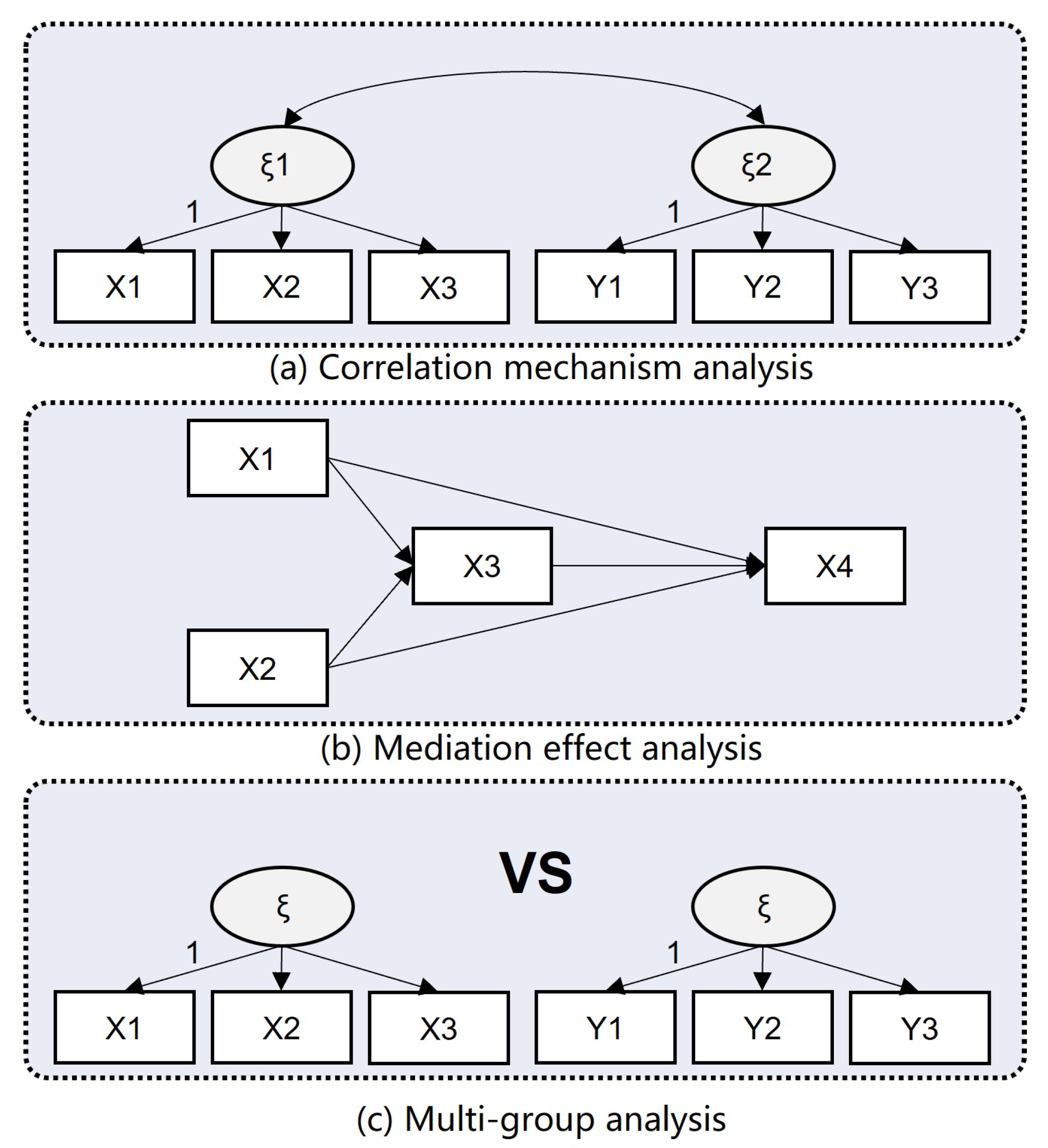
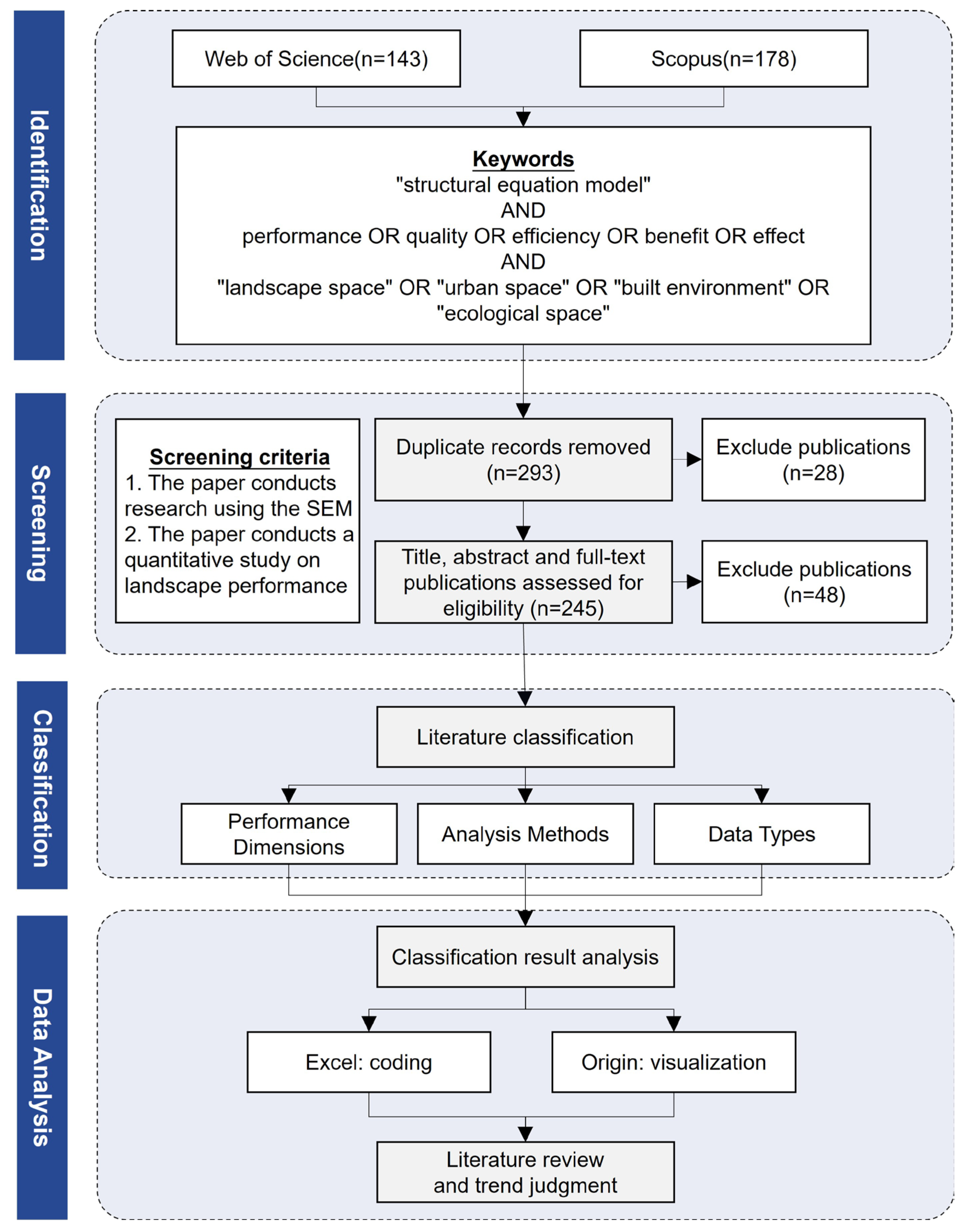
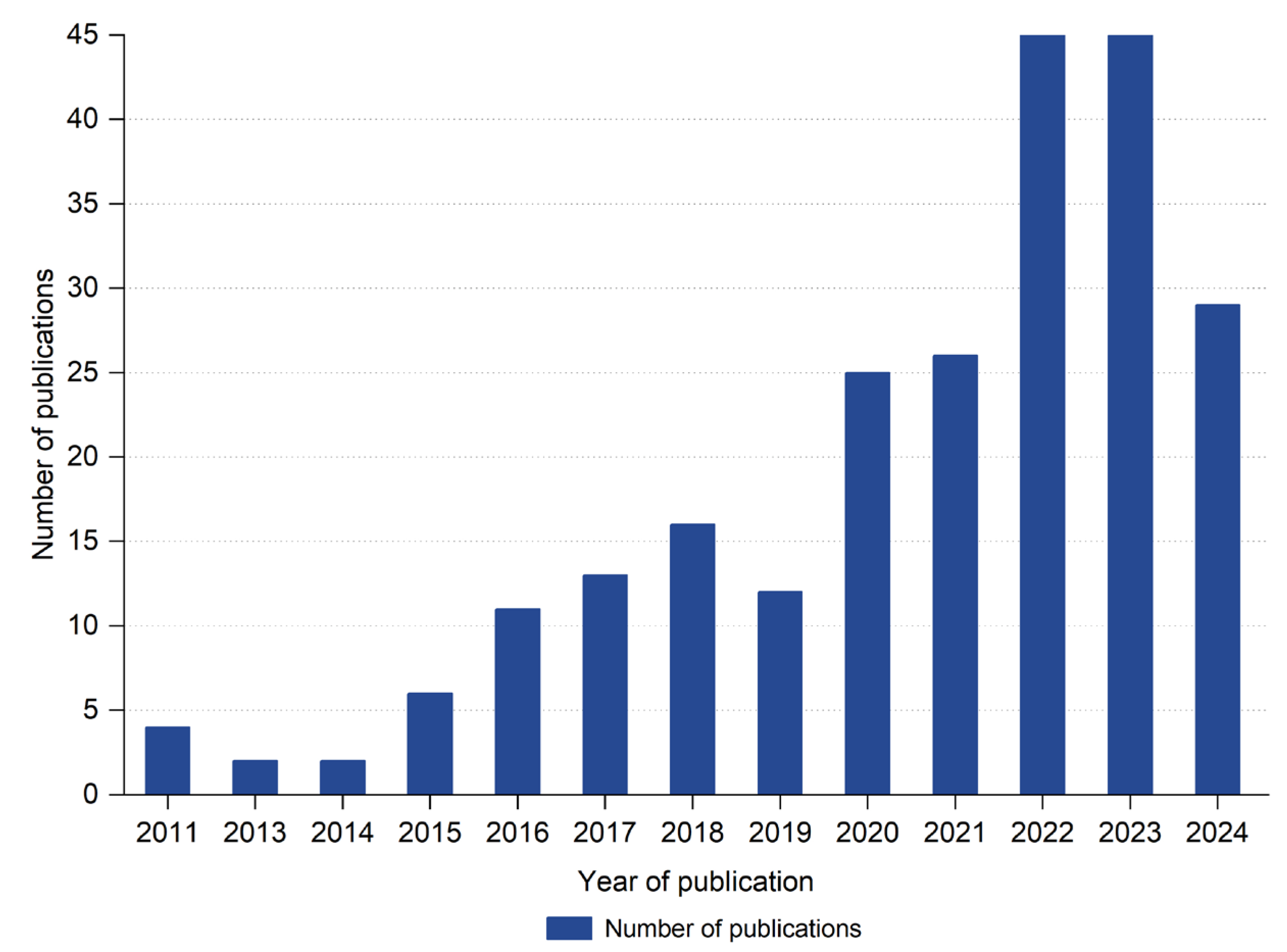

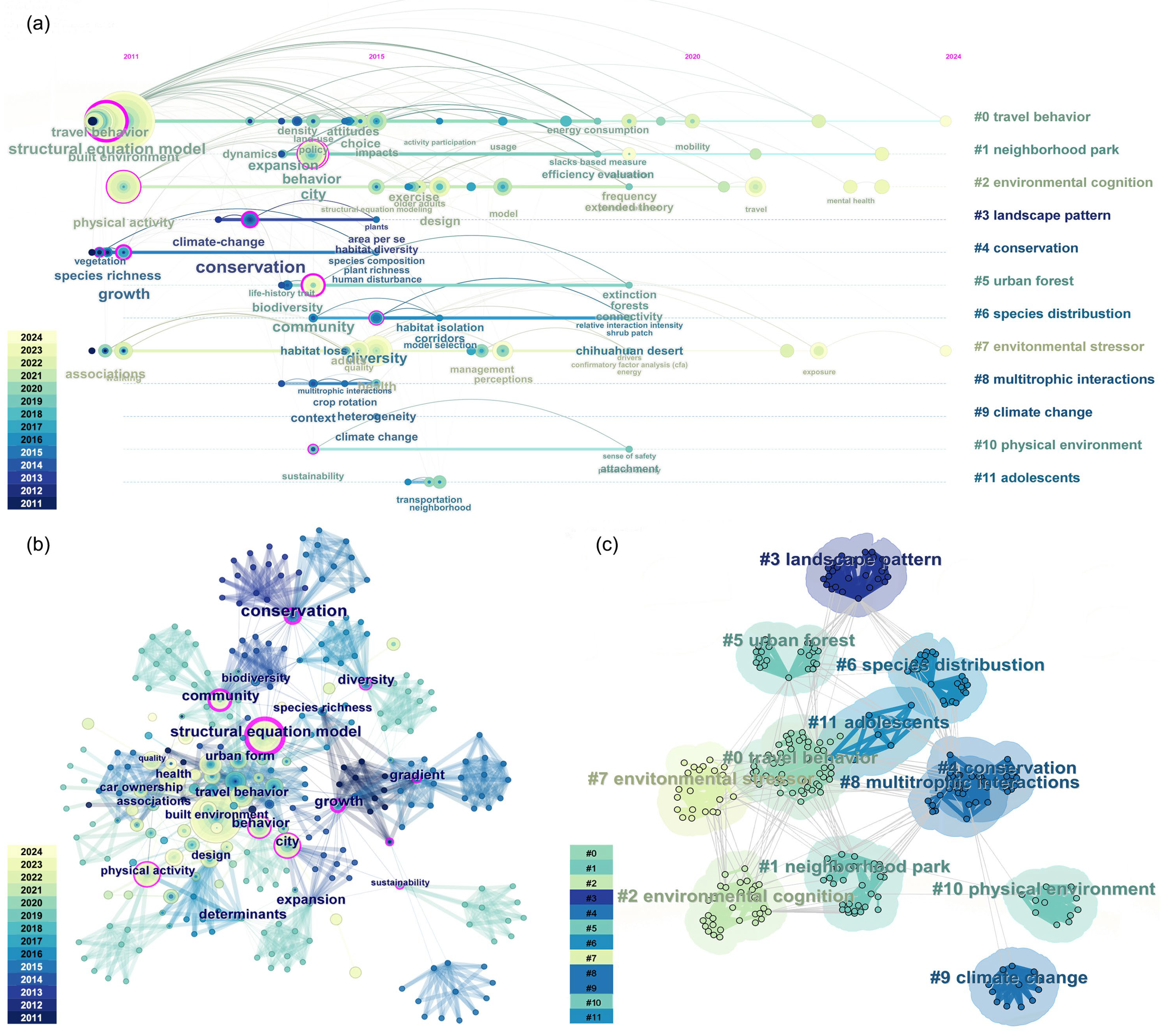


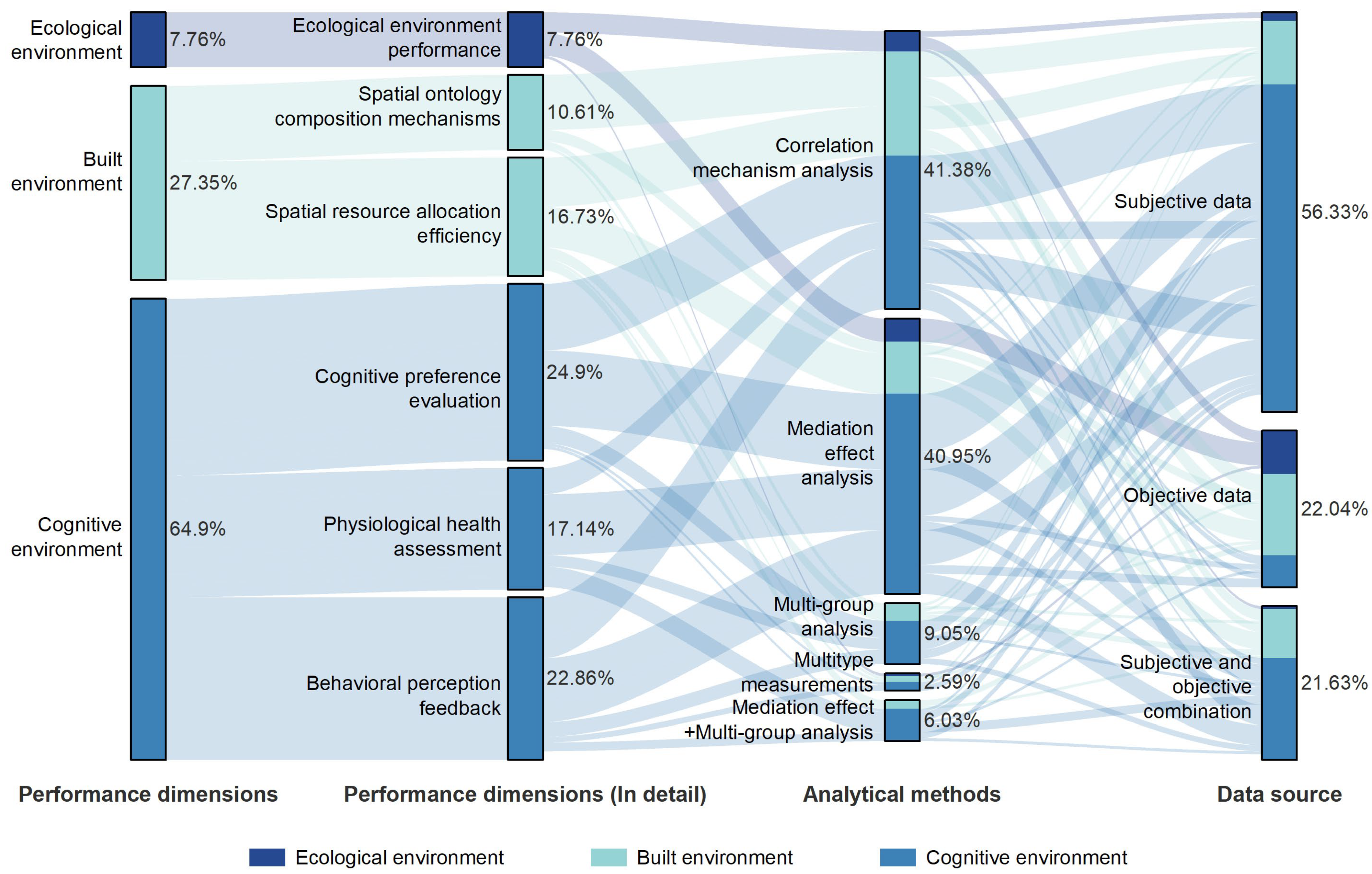

| Journal | n (%) |
|---|---|
| Urban Forestry and Urban Greening | 27 (11) |
| Landscape and Urban Planning | 25 (11) |
| Transportation Research Part A: Policy and Practice | 12 (5) |
| Sustainable Cities and Society | 11 (4) |
| Landscape Ecology | 11 (4) |
| Transportation Research Part D: Transport and Environment | 10 (4) |
| Journal of Transport Geography | 9 (4) |
| International Journal of Environmental Research and Public Health | 9 (4) |
| Cities | 9 (4) |
| Travel Behaviour and Society | 8 (3) |
Disclaimer/Publisher’s Note: The statements, opinions and data contained in all publications are solely those of the individual author(s) and contributor(s) and not of MDPI and/or the editor(s). MDPI and/or the editor(s) disclaim responsibility for any injury to people or property resulting from any ideas, methods, instructions or products referred to in the content. |
© 2025 by the authors. Licensee MDPI, Basel, Switzerland. This article is an open access article distributed under the terms and conditions of the Creative Commons Attribution (CC BY) license (https://creativecommons.org/licenses/by/4.0/).
Share and Cite
Han, X.; Li, Z.; Chen, H.; Yu, M.; Shi, Y. Structural Equation Model in Landscape Performance Research: Dimensions, Methodologies, and Recommendations. Land 2025, 14, 646. https://doi.org/10.3390/land14030646
Han X, Li Z, Chen H, Yu M, Shi Y. Structural Equation Model in Landscape Performance Research: Dimensions, Methodologies, and Recommendations. Land. 2025; 14(3):646. https://doi.org/10.3390/land14030646
Chicago/Turabian StyleHan, Xiao, Zhe Li, Haini Chen, Mengyao Yu, and Yi Shi. 2025. "Structural Equation Model in Landscape Performance Research: Dimensions, Methodologies, and Recommendations" Land 14, no. 3: 646. https://doi.org/10.3390/land14030646
APA StyleHan, X., Li, Z., Chen, H., Yu, M., & Shi, Y. (2025). Structural Equation Model in Landscape Performance Research: Dimensions, Methodologies, and Recommendations. Land, 14(3), 646. https://doi.org/10.3390/land14030646












